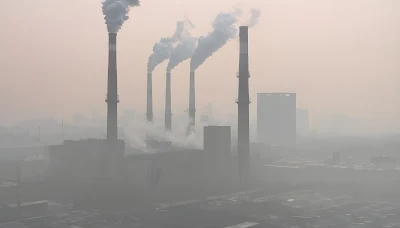Looking for [Week 1-12] NPTEL Air pollution and Control Assignment Answers 2024? Dive into this detailed guide covering everything you need to know ab
Welcome to the ultimate guide for [Week 1-12] NPTEL Air Pollution and Control Assignment Answers 2024! In this comprehensive article, we'll delve into the intricate world of air pollution, exploring its causes, impacts, and most importantly, solutions. Whether you're a student seeking answers for your assignments or simply curious about environmental issues, this guide is your go-to resource.
Understanding Air Pollution
Air pollution is a pressing global concern, adversely affecting both the environment and human health. It encompasses a variety of pollutants, including particulate matter, sulfur dioxide, nitrogen oxides, and volatile organic compounds. These pollutants arise from diverse sources such as vehicular emissions, industrial activities, and agricultural practices.
Sources of Air Pollution
Industrial Emissions
Industrial activities contribute significantly to air pollution, releasing pollutants such as sulfur dioxide, carbon monoxide, and particulate matter into the atmosphere.
Vehicular Emissions
The combustion of fossil fuels in vehicles generates pollutants like nitrogen oxides and hydrocarbons, contributing to urban air pollution.
Agricultural Practices
Certain agricultural activities, such as burning crop residues and using chemical fertilizers, can release pollutants into the air, worsening air quality.
Impacts of Air Pollution
The ramifications of air pollution are far-reaching, affecting both the environment and public health.
Environmental Impacts
Climate Change
Air pollutants like carbon dioxide contribute to global warming and climate change, altering weather patterns and disrupting ecosystems.
Degradation of Natural Habitats
Pollutants can harm plant and animal species, leading to biodiversity loss and ecosystem degradation.
Health Impacts
Respiratory Diseases
Exposure to air pollution increases the risk of respiratory conditions such as asthma, bronchitis, and lung cancer.
Cardiovascular Effects
Air pollutants can also elevate the risk of cardiovascular diseases, including heart attacks and strokes, due to their inflammatory effects on the cardiovascular system.
Mitigation Strategies
Addressing air pollution requires concerted efforts at individual, community, and governmental levels.
Promoting Clean Energy
Transitioning to renewable energy sources such as solar and wind power can reduce reliance on fossil fuels, mitigating air pollution.
Enhancing Transportation Systems
Investing in public transportation and promoting electric vehicles can curb vehicular emissions, improving air quality in urban areas.
Regulating Industrial Emissions
Implementing stringent emission standards and incentivizing industries to adopt cleaner technologies can minimize industrial pollution.
[Week 1-12] NPTEL Air Pollution and Control Assignment Answers 2024
Now, let's delve into the specifics of the [Week 1-12] NPTEL Air Pollution and Control Assignment Answers 2024. Below are detailed insights and solutions to help you ace your assignments:
Question 1:
What are the primary sources of air pollution, and how do they contribute to environmental degradation?
Air pollution stems from various sources, including vehicular emissions, industrial activities, and agricultural practices. These activities release pollutants into the atmosphere, leading to environmental degradation through the emission of greenhouse gases and harmful chemicals.
Question 2:
Discuss the health impacts of air pollution on human populations.
Air pollution poses significant health risks, exacerbating respiratory diseases such as asthma and increasing the incidence of cardiovascular conditions like heart attacks and strokes. Prolonged exposure to pollutants can impair lung function and compromise overall well-being.
Question 3:
What measures can be taken to mitigate air pollution on a global scale?
Mitigating air pollution requires multifaceted approaches, including transitioning to clean energy sources, improving transportation systems, and implementing stringent regulations on industrial emissions. Additionally, fostering public awareness and community engagement is crucial for promoting sustainable practices.
Frequently Asked Questions
How does air pollution impact children's health?
Air pollution can adversely affect children's respiratory health, leading to conditions like asthma and developmental issues. Children are particularly vulnerable to the harmful effects of pollutants due to their developing immune systems.
What are the economic consequences of air pollution?
Air pollution imposes significant economic burdens, including healthcare costs associated with treating pollution-related illnesses and productivity losses due to absenteeism and decreased workforce efficiency.
Can indoor air quality impact health?
Yes, indoor air quality can profoundly impact health, as indoor environments may contain pollutants from sources such as cooking appliances, cleaning products, and tobacco smoke. Proper ventilation and the use of air purifiers can help mitigate indoor air pollution.
How does air pollution contribute to climate change?
Air pollutants such as carbon dioxide and methane trap heat in the Earth's atmosphere, leading to global warming and climate change. This phenomenon alters weather patterns, exacerbates extreme weather events, and poses threats to ecosystems and human societies.
Are there disparities in air pollution exposure among different demographic groups?
Yes, certain demographic groups, including low-income communities and minorities, often face disproportionate exposure to air pollution due to factors such as proximity to industrial facilities and lack of access to green spaces. This environmental injustice exacerbates existing health disparities.
What role can individuals play in combating air pollution?
Individuals can contribute to air pollution mitigation efforts by adopting sustainable practices such as reducing energy consumption, using public transportation, and supporting policies that promote environmental conservation.
Conclusion
In conclusion, tackling air pollution is paramount for safeguarding both environmental sustainability and public health. By implementing proactive measures at local, national, and global levels, we can mitigate the adverse effects of air pollution and create a cleaner, healthier future for generations to come.













COMMENTS